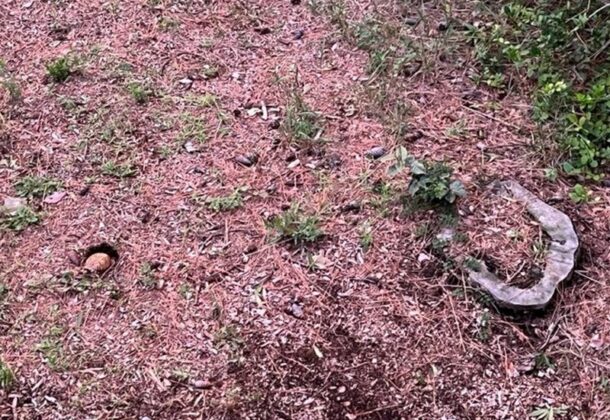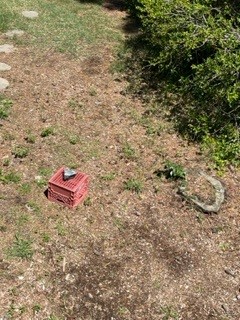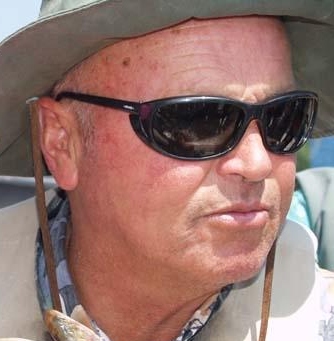Message from a Cap’n: Season of Jellyfish, Turtles, Ospreys

Can you see her on the left? At dusk, a box turtle prepares the shallow nest to lay her eggs, she hopes unnoticed by predators now and during their incubation through July and August.
Message from the Cap’n is a compilation of fishing advice, waterman and weather insights, Chesapeake lore, and ordinary malarkey from the folks who keep their feet wet in the Potomac and St. Mary’s rivers.
Chesapeake Bay Interpretive Buoy System was showing water temperatures in the Potomac at 83 degrees F. and Salinity at 15 PSU — before last week’s heatwave hit. All regions of the Chesapeake can be accessed by changing locations at the site linked above to find current data. The service has been online since 2007.
With the water temperature in the 80s jellyfish are taking over. The Chesapeake Bay Foundation offers Four Surprising Facts About Chesapeake Jellyfish including the good/bad news that their populations are increasing. The good part of that news, and another surprising fact, sea nettles act as a friend to Chesapeake Bay oysters.
Crabbing has been good over the last several weeks as more Chesapeake Bay blue crabs have moved into the lower Potomac. No. 1 Males are bringing around $100, No. 2s are bringing roughly $40 and sooks are $40 also.
Soft crabs have been very scarce this summer with large crabs bringing about $60 per dozen. The cold wet spring threw the normal shedding cycle out of whack up and down the coast from Delaware to the Carolinas. Smith Island, Tangier, and the Eastern shore of Virginia have had a tough scraping season due to weather also.
The Ospreys have had a rough spring as well. Floods of rain with cold temperatures have slashed the nesting productivity. There are still about 60 Osprey nesting platforms scattered around St. George Island. To give a snapshot of the reduction, of 16 active osprey nests within telescope sight of Sea-Fruit Oyster House, only three nests hatched nestlings this year. There are a total of six nestlings in the three nests: Three, two, and one in respective nests. The eldest of these osprey chicks began fledgling toward July 18.
 A box turtle (Turkle: local dialect according to the Cap’n) laid eggs on June 24 in our yard on St. George Island. We covered the spot with a metal milk crate to protect it from hungry foxes or raccoons. A huge rock on top ought to do the trick.
A box turtle (Turkle: local dialect according to the Cap’n) laid eggs on June 24 in our yard on St. George Island. We covered the spot with a metal milk crate to protect it from hungry foxes or raccoons. A huge rock on top ought to do the trick.
Speaking of raccoons: one got into the shedding float and ate five or six of my peelers several nights ago. A varmint trap set with a Hostess Twinkie has lured many a racoon before …. I’ll keep you posted …..
Box turtles hatch between 50 to 90 days, depending on temperature, which also determines a box turtle’s gender. Clutches incubated at temperatures of 72 to 80 degrees Fahrenheit produce mostly males; above 83, mostly females. They will already know this place when they hatch. They have a homing instinct that functions like an internal GPS. They can easily navigate through their home territories. However, if they are moved outside of where they live, it can cause confusion, according to Maryland DNR.
Adult box turtles often live 30 to 40 years in the wild and some are believed to have reached 100 years or more. within a territory about the size of a football field. But their populations are declining, traffic is one cause. So safely helping a turtle cross the road is encouraged by conservationists who recommend placing the turtle where it appeared headed.
In addition to giving turtles a brake, MD DNR recommends helping is to conduct a “turtle sweep” before mowing.
There have been numerous sightings of box turtles in the neighborhood, but as I found out trying to catch a photo of a Diamondback terrapin was digging a hole to lay her eggs. I scared her and she left the hole. I’ll keep checking . . .
In the meantime, remember “It’s Our Bay, Let’s Pass It On.”
To learn about tours and trips into the Chesapeake, keep in touch with Fins + Claws on Facebook . Catch up on Messages from the Cap’n Member Page. Please visit Cap’n Jack’s lore and share with your social media sites. Or reach him here: [email protected] or 240-434-1385.

























Good article,Capn